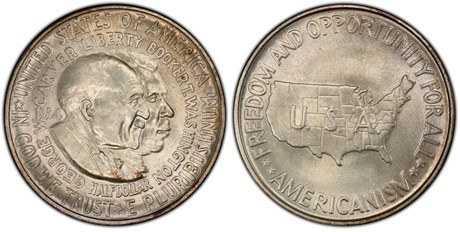American Memorial Half-Dollar, Part IV: The End of the Road
Release time:2023-05-17

The Washington-Carver Half-Dollar, issued in 1954, was the last classic commemorative coin issued from 1892 to 1954. Courtesy of PCGS TrueView.
There are many coin dealers who jump on the ranks of souvenirs, so to speak. Why don't they? There are dozens of cool new questions, most with exciting stories. Despite these interesting coins and wonderful stories, by the end of the 30s of the 20th century, the light of the commemorative coin project began to fade.
Many, like the main coin dealer B.Max Mehl, have created a marketplace among the many coins they sell, offering buy and sell prices for these coins. Although there were several books on the subject and many dealers tried to sell the commemorative half-dollar, the 1939 Arkansas and Oregon half-dollar P-D-S suits were essentially an afterthought, not a product that stemmed from strong demand from collectors.
Unsurprisingly, on August 5, 1939, Congress passed a bill prohibiting the production or distribution of Treasury stockpiles of souvenirs authorized before March 1, 1939. Only 2,000 P-D-S sets were produced in Arkansas in 1939, and 3,100 in 1939 in Oregon's half-dollar P-D-S set. With inventories of early releases in Arkansas and Oregon both present and offered to the public at slightly above face value, both 1939 P-D-S suits barely sold well. Ironically, today's coin collectors benefit from many of the problems that sold poorly in the past.
Many may think that World War II was part of the reason for the demise of the commemorative half-dollar circulation after the late 1930s, but the United States entered the war two years later, in 1941. Q. David Bowers, in his book American Commemorative Coins: A Complete Encyclopedia, "The existing commemorative coin market continued to drift downward, which began in the late summer of 1936, when the boom peaked, bottoming out around 1940-41." After that, supply equals demand, most speculators have sold, and market levels reflect the price collectors are willing to pay. "
Interestingly, despite the sluggish commemorative coin market, the collectible coin market really took off in the late 2030s. Of course, World War II affected the market, but the new coin album that debuted before the war proved to be very popular at the time. By the way, the launch of these albums accelerated the quest for different mineral-tagged coins in a particular collection, rather than just collecting coins from each date – a common practice among early collectors.
World War II did affect the production of American coins, but long before the end of the war in 1945, many suggested continuing the issuance of certification and commemorative coins suspended in 1942 after the war finally ended. In fact, in 1944 and 1945, the prices of most collectibles increased significantly. The commemorative half-dollar is still cheap, but collector demand has recovered well. Aubrey Bebee of Bebee's Stamp and Coin in Omaha, Nebraska, features the collection with plenty of souvenirs – especially P-D-S sets.
Although I didn't have any direct experience with Mehl, during my career wholesaling rare coins, I purchased hundreds of commemorative coins – usually P-D-S sets – originally sold by Bebee's. Sometimes, these coins came in Bebee's original packaging, but the cellophane (often original) of many of the P-D-S set coins used by Bebee's was quite unique and (at the time) quite well preserved the coins.
Summary....
Every coin has two sides. Yes, many souvenirs have a large number of promotions and often have a large surplus that has not been sold for years. But would we have had not had Mehl, Bebee and other dealers who promoted these coins from the beginning, would we have such a good supply of American souvenirs today?
It's true that collectors have many avenues for coin collection, but the classic commemorative half-coin offers many exciting options. Depending on your collection goals, focusing on the harder early "first third" questions, in terms of budget and difficulty, it should be easier to build a 50-piece type (or full 144 coins) souvenir set. Later, post-Depression problems not only existed at a higher level, but were often more accessible. With the classic commemorative project ending in 1954, nearly 30 years later, the next commemorative coin would be introduced from the printing press of the United States Mint in 1982.
Despite the sometimes tumultuous past, the American Classic Commemorative Coin is still one of the most exciting collections one can start collecting. Spanning two centuries, two world wars, and countless historic moments, classic commemorative coins from 1892 to 1954 have helped define our society and the world today, providing collectors with unprecedented challenge and fun.
keyword:American Memorial Half-Dollar, Part IV: The End of the Road



